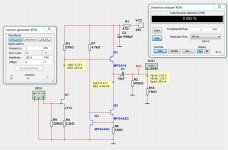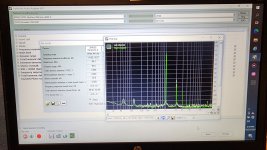Yes, I have simulated a bunch of Hamptone.
Now I tested with J113 and MPSA14.
Got a bit better result with MPSA14 compared to MPSA42.
Also trying to have only 500uA through the J113. Seems the best.
This is the best so far.
I always test the output at 1Vrms into 10k load.
This way I can compare with same output level.
Now I tested with J113 and MPSA14.
Got a bit better result with MPSA14 compared to MPSA42.
Also trying to have only 500uA through the J113. Seems the best.
This is the best so far.
I always test the output at 1Vrms into 10k load.
This way I can compare with same output level.
Attachments
The circuit does not have global negative feedback.Maybe PMA can sketch the feedback path?
R12/R18 provide local negative feedback for input jfet.
I find it so fascinating to see the low THD without global feedback of above circuits.
Also the absence of 'bandwidth limiting' capacitors is compelling.
It's like 'super fine tuning' the actual transfer functions/characteristics of transistors.
As is the miracle of semiconductors, so is the ability of actually hearing them
Also the absence of 'bandwidth limiting' capacitors is compelling.
It's like 'super fine tuning' the actual transfer functions/characteristics of transistors.
As is the miracle of semiconductors, so is the ability of actually hearing them
That takes me so far back in timeHad to ground the pot case, as it was buzzing when touched. Now its quiet.
Definitely worth exploring further.
It works from 15 to 25 vdc, i use 18 vdc regulated.
I can remeasure at 1Vrms and see what i get.Yes, I have simulated a bunch of Hamptone.
Now I tested with J113 and MPSA14.
Got a bit better result with MPSA14 compared to MPSA42.
Also trying to have only 500uA through the J113. Seems the best.
This is the best so far.
I always test the output at 1Vrms into 10k load.
This way I can compare with same output level.
It has cap on output, it has to, since its not using symetrical power supply.I find it so fascinating to see the low THD without global feedback of above circuits.
Also the absence of 'bandwidth limiting' capacitors is compelling.
It's like 'super fine tuning' the actual transfer functions/characteristics of transistors.
As is the miracle of semiconductors, so is the ability of actually hearing them
Original Hamptone has two balancing transformes, one on input, one on output.
Those are fr limited.
Yes, I have simulated a bunch of Hamptone.
Now I tested with J113 and MPSA14.
Got a bit better result with MPSA14 compared to MPSA42.
Also trying to have only 500uA through the J113. Seems the best.
This is the best so far.
I always test the output at 1Vrms into 10k load.
This way I can compare with same output level.
Thank you for the wonderful information above 
I thought there was something a bit special about the above circuits > Talk about gain & bandwidth - WOW.
I found this OLD post, wondering about class A opamps >
I've been forcing opamps in class A since the late 80s.
For opamp preamp's, opamp driven Mosfet class A amplifiers, currently in rebuilt partly class A 4-channel car power amplifiers with OPA627 and sanken1216/2922, and in the Stokes SDS class A headphone amplifier with RFP12N20/RFP12P10 Mosfet outputs.
With many different opamps from 5532/5534, OP27, LT1028, now OPA627 and OPA637.
Also the 134, and 2134.
Difference was staggering on every attempt.
Not surprising as mosfets only sound any good driven in class A(imo), think of the number of fets in an opamp.
Think of glueing a heatsink on top of the opamp, if you are planning to stretch it.
I thought there was something a bit special about the above circuits > Talk about gain & bandwidth - WOW.
I found this OLD post, wondering about class A opamps >
I've been forcing opamps in class A since the late 80s.
For opamp preamp's, opamp driven Mosfet class A amplifiers, currently in rebuilt partly class A 4-channel car power amplifiers with OPA627 and sanken1216/2922, and in the Stokes SDS class A headphone amplifier with RFP12N20/RFP12P10 Mosfet outputs.
With many different opamps from 5532/5534, OP27, LT1028, now OPA627 and OPA637.
Also the 134, and 2134.
Difference was staggering on every attempt.
Not surprising as mosfets only sound any good driven in class A(imo), think of the number of fets in an opamp.
Think of glueing a heatsink on top of the opamp, if you are planning to stretch it.
I typically stack identical preamps.
To 'color' the sound, i use step up transformer, that's my secret weapon.
I introduce 'color' as latest as possible. And only as minimum as required. Keep it clean as long as possible, then modify to make it musical. I like lush, yet clean.
To 'color' the sound, i use step up transformer, that's my secret weapon.
I introduce 'color' as latest as possible. And only as minimum as required. Keep it clean as long as possible, then modify to make it musical. I like lush, yet clean.
My best pre is either opa604 buffer followed by edcor transformer, or jfet buffer followed by step up transformer. You can find jfet buffer in my simple active crossover. It almost the same as vfet front end or m2.
Or i use tube pre, i got three finished, best one is srpp with 6n11 tubes, with lowest distortion. But it does not drive step up well. There is thread about it somewhere.
Or i use tube pre, i got three finished, best one is srpp with 6n11 tubes, with lowest distortion. But it does not drive step up well. There is thread about it somewhere.
Hi there,I typically stack identical preamps.
To 'color' the sound, i use step up transformer, that's my secret weapon.
I introduce 'color' as latest as possible. And only as minimum as required. Keep it clean as long as possible, then modify to make it musical. I like lush, yet clean.
Your last 2 posts made me wonder to ask the question:
When it comes to line level audio transformers, what are the best 'top 5 or so' manufactures?
- Home
- Source & Line
- Analog Line Level
- Hamptone


